Prasat Bakong is the first great pyramid or mountain temple constructed in sandstone to be built by the ancient Khmer. Consecrated in the late 9th century during the reign of King Indravarman I, it was the centrepiece of the ancient city of Hariharalaya that we know today as Roluos.
Visiting Bakong Temple
The site is located around 15 km east of the Siem Reap city centre and easily reached via sealed roads either by car, tuk-tuk, moto, or even bike. On the eastern and western entrances of the site, you’ll find drink and food stalls, plus some selling local souvenirs. You can easily spend an hour here and the area is very a very pleasant place to spend time.
Highlights of Bakong are the central tower atop the great stepped pyramid, the monolithic elephant statues guarding each corner, the artwork that remains in select places, and, the beautiful brick towers and structures that surround the pyramid. If you have more time, there are even more brick temples surrounding the outside of the moat and enclosure, more on those here.
Nearby, Lolei Temple, Preah Ko, Prei Monti, and Trapeang Totoeng Thngai are easy to visit while Trapeang Phong is a little more of an adventure but well worth the effort. There is even more in the wider Roluos area. You will need an Angkor Pass, which covers all the sites and you should set aside half a day or even a whole day to visit the several temples here.
A few hundred meters east of Prasat Bakong is Bakong My Village, which offers a landscaped garden with a coffee shop and restaurant. It’s a nice place to relax and is incredibly popular on weekends.
Site Layout & Features
As seen in image B below, the Bakong Temple site is large, featuring an outer moat that is dry today enclosing a series of brick towers and constructions that surround the walled enclosure and moat of the temple proper. Much of this area has only recently been cleared with some of the brick towers opened up for public visiting and more on those here.
The focus of the Bakong Temple site is the temple proper located inside the enclosure wall and inside the 2nd moat which is where we will begin, starting from the main entrance pavilion which is on the east side.
Inside this enclosure, a causeway that crosses the moat is lined by the remnants of monumental naga balustrades which are believed to be the first use of such in Khmer architecture. Those resting by the eastern causeway are in the best condition, one of which still retains great detail. After crossing the moat, is another enclosure, fronting which, to the north of the causeway is a contemporary pagoda which retains some beautiful murals and sandstone sema that likely date to around the 16th century or later.
Entering through the enclosure, this section of the causeway is flanked by bollards and two long halls on an east-west axis which are both preceded by two smaller shrines. Two further long halls flank the causeway just after the gopura, these, on a north-south axis. At each corner are two brick libraries with those on the south being the best preserved and retaining images of ascetics in their upper level and the interesting fluted windows that never carried over to later temple sites. On the southeast side, there is the remnants of another long hall on an east-west axis which is seemingly similar to the one at Preah Ko, situated in a similar position.
Continuing along the causeway, it then leads to the sandstone pyramid featuring five stepped levels. We’ll head straight to the top.



At the top of the pyramid rests the central tower, opening to the east with a pediment above its doorway depicting Vishnu Anantasayin (or the Birth of Brahma) with redented sidewalls adorned with deity reliefs flanked by ornate pilasters. Note the unique characters at the bottom of those pilasters. The other three sides, featured false doors, again flanked by a deity, ornate pilasters, and doorways topped by lintels albeit very decayed. This theme continues up the levels of the tower that reduce in size as they go.

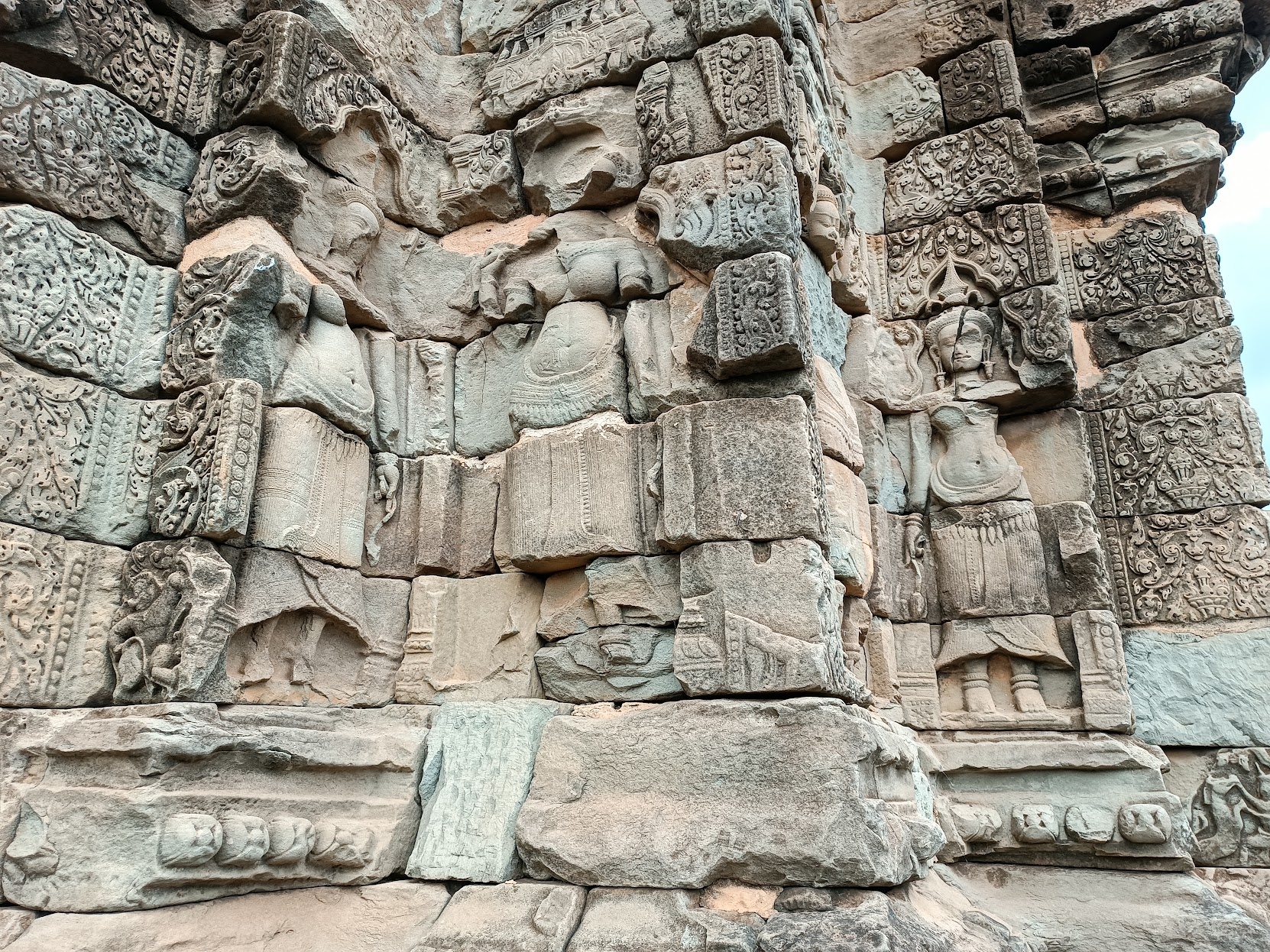

On the next level down, twelve mini-towers line the perimeter and look around the wall of the preceding level here to see the decayed remnants of what would have once been a beautiful and ornate relief wall, in places you can still see the outlines of many characters with one or two blocks retaining some clear detail.

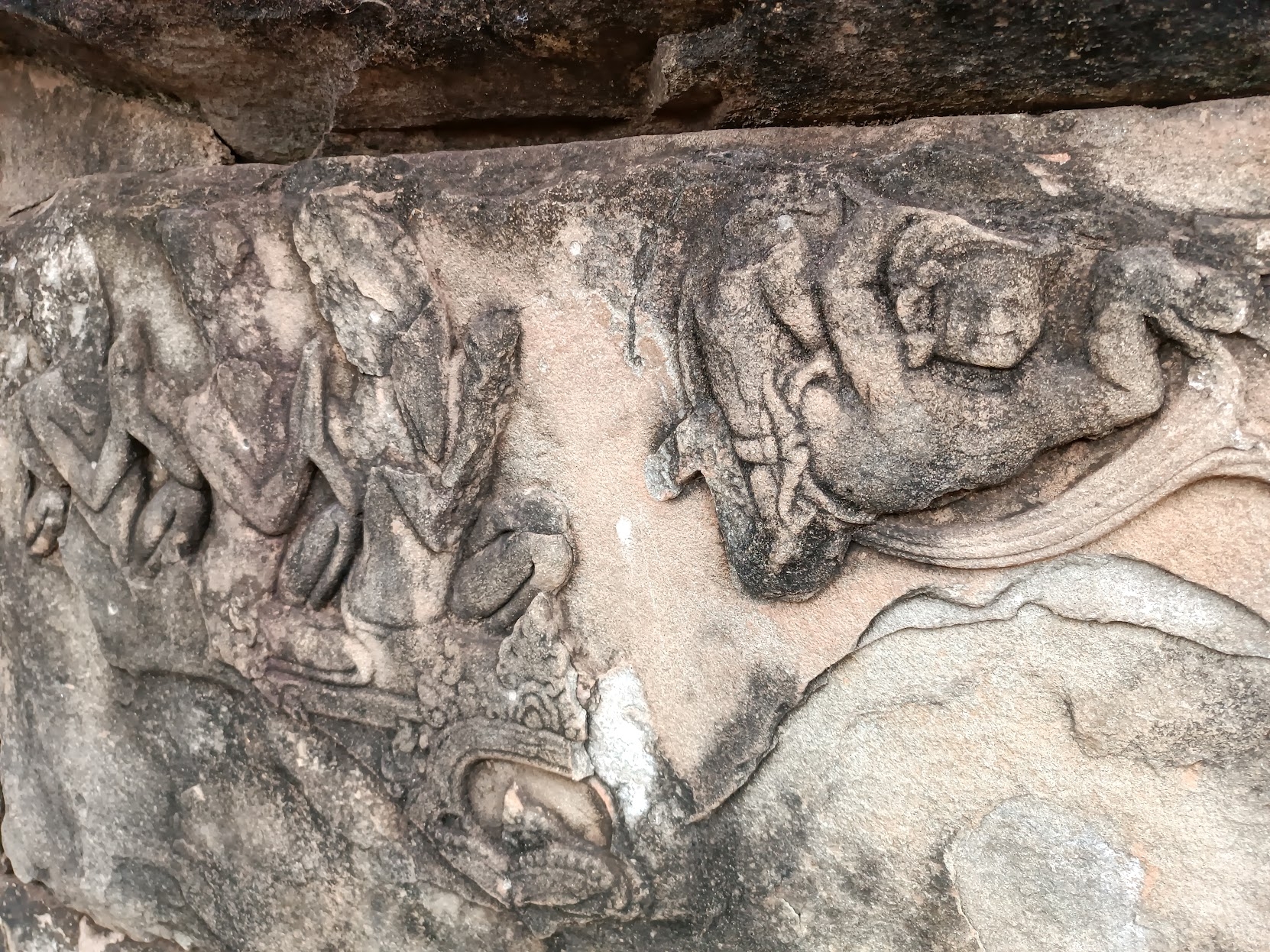

On the next three levels, monolithic elephants guard each corner while lions guard the staircases. On the lowest level, entrance gopuras at each cardinal point give access to the stairs leading up. On the staircases, below the lions, you can see the reliefs of Dvarapala and deity. At the edge of the platform of each level, you can see notches that may have received wooden beams to support a roof structure.
Immediately surrounding the pyramid are eight symmetrically placed monumental brick towers, some of which have recently completed restoration and some with restoration ongoing, featuring beautiful lintels, door columns, and deities adorning the walls that should not be missed.
At the northwest and southwest corners, inside the enclosure, there are the remnants of square brick buildings that open to the east.
Layout images via BEFEO/Persee


Highlights Gallery
Images are from 2021 and 2022.



















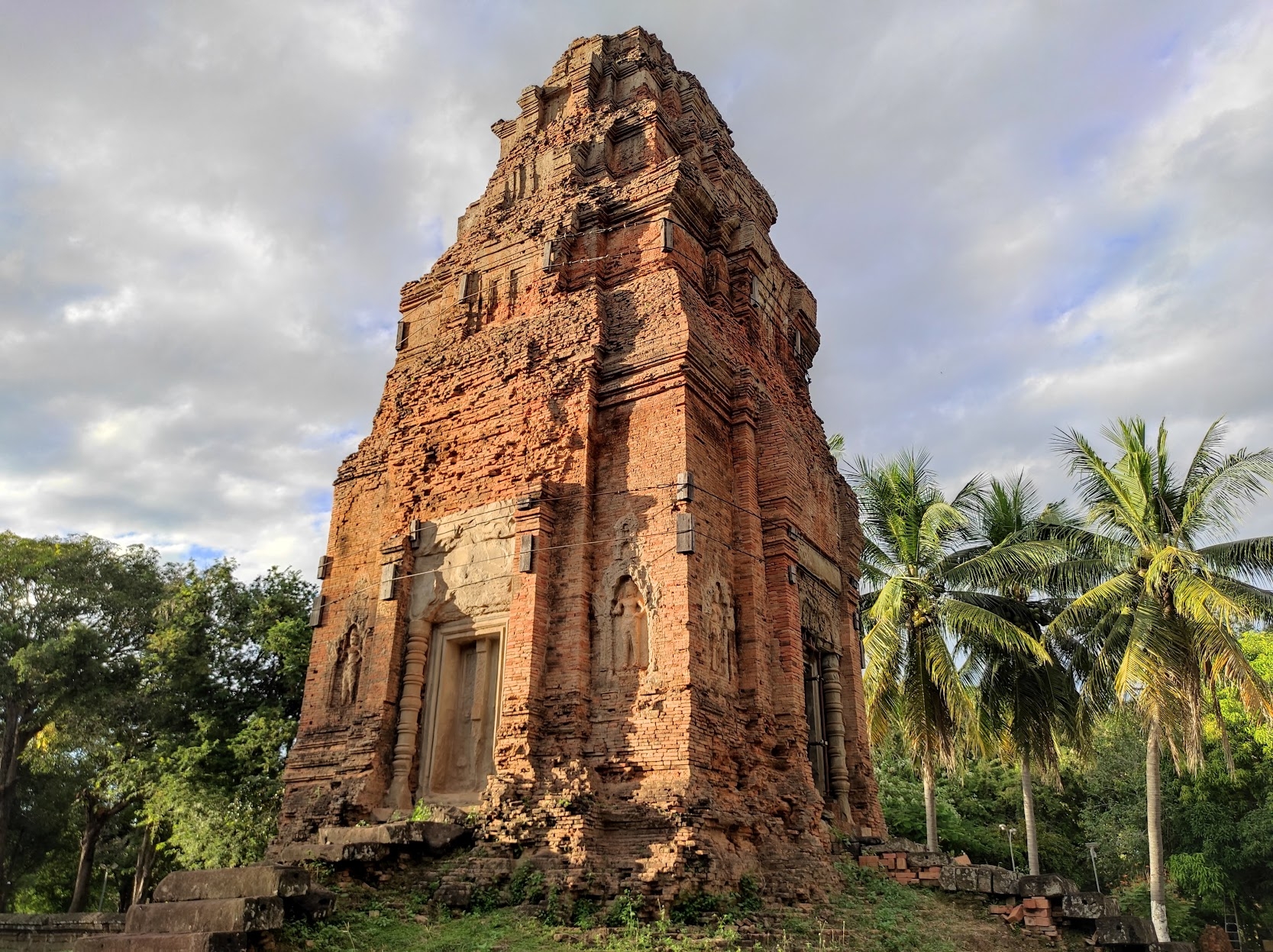



History
According to the inscribed stele which was found in the entrance pavilion in 1935, the site was consecrated in 881 AD during the reign of King Indravarman I. It is the first sandstone “mountain temple” inspired by the Hindu myth of Mount Meru and would certainly be the pivotal temple of the ancient capital and city, Hariharalaya, that was believed to be founded by Jayavarman II. Indravarman’s son and successor, Yasovarman, would later complete Bakheng temple, in many ways similar to Bakong, and create a new capital for the empire, Yashodharapura.
In 1935, the French began archeological research on the site and clearing, in turn locating the inscribed consecration or foundation stele that would be registered under K. 825 (later as K. 826) inside a small laterite pavilion on the east side inside the enclosure. The Inscription in Sanskrit featured 31 lines on the first side and 22 on the second including an invocation; a tribute to Indravarman noted as being similar to that found inscribed at the nearby Preah Ko temple; noting of the foundation in 803 caka (881 A. D.) of the linga Sri Indresvara and the eight murti of Shiva, here, in the courtyard of Sri Indresvara; erection of various statues, and various foundations (Coedes notes as probably outside Bakong); enumeration of gifts etc. also noted as being identical to those inscribed at Preah Ko.
In 1936, the pyramid was cleared of the brick and wooden structure atop the site that had been built by monks revealing a sandstone base of the central tower that we see in place today. The tower was reconstructed from its pieces that laid around the pyramid. At that time they also cleared the central well only to find it had previously been looted. At this time, other pieces were found including a contemporary Chinese sword and iron instruments. Reconstruction of the central tower began with the oddity of the art styles noted.
In 1937 Maurice Glaize continued to leads works on reconstructing the central tower, his notes offer fascinating insight, provided here and translated from French (original BEFEO 37 pg 629)
Bakon (Rolüos), the operation proved to be all the more delicate in that it involved a complete resurrection of the central sanctuary adorning the pyramid (fig. 49 and pl. XCVI), without further information on its nature and its dimensions other than what is indicated by the recess in the sandstone paving of the upper platform being that of the outer contour of the ancient prasat.
It was therefore necessary, once the excavations had been carried out, to identify in a veritable chaos the blocks that could have come from the building that had disappeared, to group them by categories of molding or decoration, and finally to assign them their respective locations by methodical classification (fig. 50).



An attempt to reconstruct one of the corner piers on the ground having proved encouraging, it was decided to attempt this real puzzle. Despite numerous gaps and the extreme state of wear of certain elements, the result exceeded all expectations, since at the end of the year the sanctuary was reassembled to the level of the cornice of the first floor in setback, 7 m. 80 of the base floor, and that the materials of the first floor are gathered on hold. Without being able to count on restoring the 3rd and 4th stages of the superstructure, of which too few stones have been found, the success is therefore now greater than that of Phnom Bakhèn, with a much more assertive silhouette.
Forming a square cella of a 2 m. 70 sideways and 4 m. 30 lengthwise, open to the east, with a forebody on each side and three false bays, the prasat features redented corner pillars, each carved with four deva: a fairly rare and rather late arrangement. The two main ones, with visible diademed hair, are sheltered under palace arcades, and flanked by two other smaller ones, topped by a mukuta under a foliage decoration. With their very developed breasts, their widely uncovered bellies and their long pleated skirts with crossed sides raised on the front, they seem to be related to the statuary of the 11th century, just like the small panels of animals and figures located at the base of the pilasters framing windows, and the seated devata of the second floor.
Also from the same period, close to the Baphon, the lintels very faded of the type III, with a central monster head placed very low, continuous horizontal branch and foliage, the octagonal columns, and the whole of the adornment, very copious and of neat execution, leaving, so to speak, nothing bare. Of a fine proportion in the mass, and largely treated in detail in its powerful molding, without excess of frills, this decoration is unfortunately in a state of wear which often makes it difficult to read.
Finally, the pediments, whose tympanum with scenes on the lower register with characters, with a steep slope, suggest, despite their state of erosion, a dancing Shiva, a Churning of the Ocean, a Vishnu Anantasayin and a Lakshmana in the middle of the monkeys, bound by the serpents of Indra could be considered almost contemporary with Angkor Wat.
If therefore the gradians of the pyramid, like the base of the base mass of the Central sanctuary belong unquestionably by their decoration at the end of the ninth century (Prah Ko-Bakhen period), the prasat now restored, is much later, either because its construction was deferred during the first works, or because it only came after replacing a first shelter made of light materials.
In 1938, the French undertook extensive work to clear the site and reconstruct the terraces along with making restorations to the brick towers and gopura. In 1939 several discoveries were made in the two square brick buildings (of which mostly only the base remains) that flank the eastern causeway near the pyramid, including bronze works, a head of a deity, and most interestingly a statue trio known as “Umagangapatisvara” (pictured below). In 1940 parts of another representation of “Umagangapatisvara” were found along with a Ganesha statue, a head of “a bodhisattva converted into Shiva” along with the successful restoration of one of the gopura.
Historical Images More at Fonds Cambodge EFEO








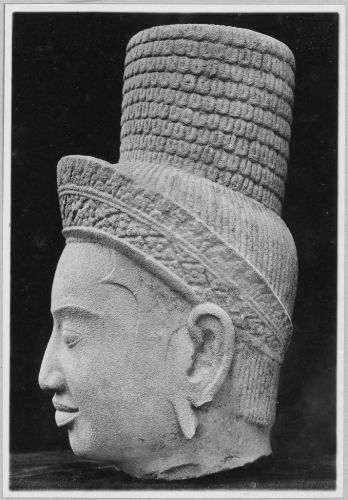


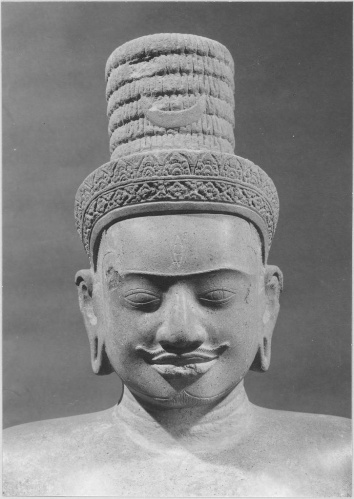



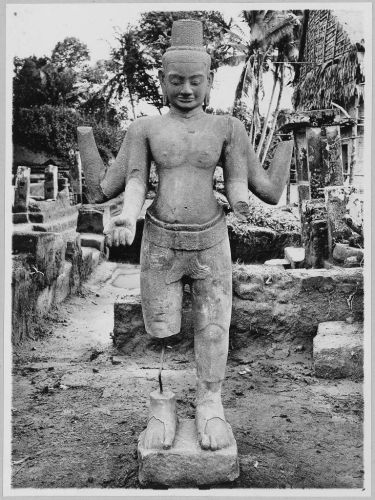








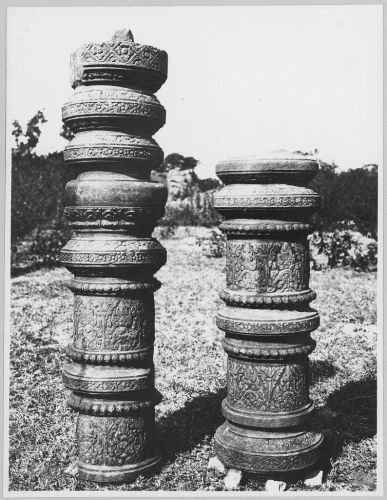
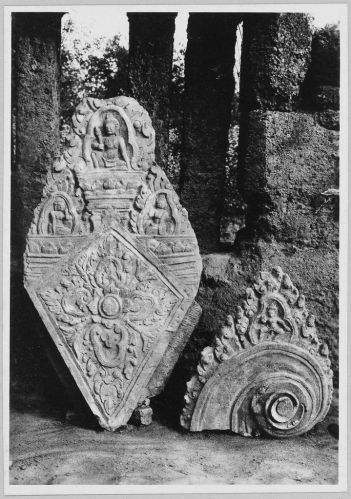

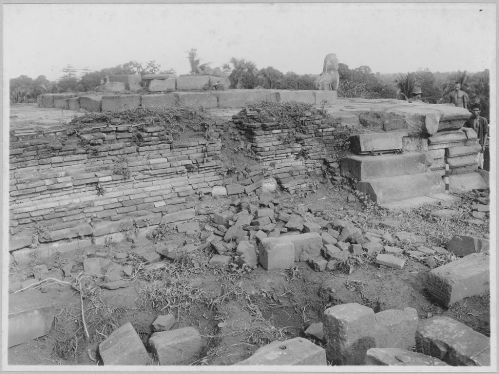



Inscriptions
- K. 304 – doorjamb south tower east side – 13 lines of Sanskrit
- K. 305 – doorjamb north tower east side – 13 lines of Sanskrit
- K. 306 – doorjamb north tower west side – 11 lines of Sanskrit – ISCC, n° XXXVII, p. 310
- K. 307 – doorjamb west tower south side – 12 lines of Sanskrit
- K. 308 – doorjamb west tower north side – 11 lines of Sanskrit
- K. 825 – three + one lines inscription/graffiti
- K. 826 – stele DCA 6434 – 31 + 22 lines of Sanskrit – IC I, p. 31 ; Bhattacharya 2009, p. 43
- K. 829 – stele (north entrance pavilion) – 22 lines of Khmer – IC IV, p. 43
- K. 870 – unknown – bronze fragments
- K. 882 – character inscription/graffiti
- K. 894 – doorjamb east tower north side – 11 lines of Sanskrit
- K. 895 – doorjamb east tower north side – Lamella/unknown – 1 line of Sanskrit
- K. 915 – doorjamb of east door of tower I – 25 lines of Khmer – Soutif 2009, p. 437-440
- K. 923 – doorjamb gate S, tower 17, north face – 5 + 22 lines of Sanskrit – IC IV, p. 39
References
- Persee/BEFEO numerous
- Chronique de l’année 1937. In: Bulletin de l’Ecole française d’Extrême-Orient. Tome 37, 1937. pp. 553-693; https://www.persee.fr/doc/befeo_0336-1519_1937_num_37_1_5396
Map
Site Info
- Site Name: Bakong (Pr.) Khmer Name: បា្រសាទបាគង
- Reference ID: HA11764 | Posted: January 20, 2021 | Last Update: November 19th, 2024
- Tags/Group: 9th Century, Angkor, Bakong, Indravarman I, Map: Top 100 Temples & Ancient Sites (Siem Reap), Roluos, Temples
- Location: Siem Reap Province > Prasat Bakong District > Bakong Commune > Thnâl Trang Village
- MoCFA ID: 481
- IK Number: 584
- Inscription Number/s: K. 304, 305, 306, 307, 308, 825, 826, 829, 870, 882, 894, 895, 915, 923

